Intel Broadwell Architecture Preview: A Glimpse into Core M
by Ryan Smith on August 11, 2014 12:01 PM ESTPutting It All Together: Low Power Core M
So far we’ve discussed Broadwell’s architecture on a broad basis, focusing on features and optimizations that are fundamental to the architecture. However to talk about the Broadwell architecture is not enough to fully explain the Core M itself. Though many of Core M’s improvements do come from Broadwell, Intel has also made a number of alterations to everything from the CPU packaging to the process node itself specifically for Core M. It’s the resulting combination of these factors that has allowed Intel to iterate on Broadwell-Y over Haswell-Y, and why Intel is so confident in Broadwell-Y’s capabilities and suitability for mobile form factors.
When it comes to building and configuring Core M, Intel likes to refer to their efforts as the “Fanless Challenge,” reflecting the fact that their biggest goal with Core M is to comfortably get the processor in to 10” tablets under 10mm in thickness that are passively cooled. A big part of getting into such a device is meeting the heat dissipation limitations of the form factor – a 10” tablet under 10mm would require a sub-5W SoC – which is where a lot of Intel’s engineering efforts have gone. Broadwell’s performance optimizations, the GPU optimizations, GPU duty cycling, and the 14nm process all contribute to getting a Core CPU’s power consumption down to that level.
But even that’s still not enough, and for Core M Intel went so far as to give Broadwell-Y its own die and design a low-power optimized version of their 14nm process just for it. This variant is designed to further reduce power consumption by optimizing the resulting transistors for lower power, lower voltage, lower clockspeed operation. By doing this Intel was able to further reduce power consumption in all of the major areas over what would be a traditional 14nm Intel process.
In the resulting 14nm Broadwell-Y process, voltage, capacitance, and leakage were all improved over the traditional 14nm process. Capacitance was reduced by 15%, minimum operating voltages by 10%, and leakage was improved to the point that it reduced SoC power consumption by 10%. The combination of all of these factors serves to significantly lower power consumption over what Intel’s traditional 14nm process would provide.
Working in concert with Broadwell-Y’s 14nm process, Intel has made a number of other changes to further reduce power consumption. Some of these are reflected in Broadwell’s overall design and others are unique to Broadwell-Y, such as using a lower TjMax for Broadwell-Y. By reducing the maximum operating temperature of the chip Intel has been able to realize further power savings by further reducing voltage and decreasing the maximum amount of temperature-dependent leakage the SoC will experience.
Meanwhile Broadwell-Y’s partner in crime, the on-package PCH, has received its own optimizations to reduce power consumption on the SoC’s total power consumption. The PCH itself is not much of a power hog in the first place – it’s still made on Intel’s 32nm process for this and cost reasons – but with such a strong focus on power consumption every watt ends up counting. As a result the Broadwell PCH-LP has seen optimizations that cut its idle power consumption by 25% and its active power consumption by 20%. Further improvements to the PCH’s monitoring hardware also mean it’s more responsive and can be controlled to a finer degree than the Haswell PCH-LP, and Intel has upgraded to a faster audio DSP to improve performance and reduce power consumption there as well.
Feeding all of that silicon in turn is Intel’s second generation Fully Integrated Voltage Regulator (FIVR), which further builds off of Intel’s other optimizations. The 2nd gen FIVR has been tuned for Broadwell-Y’s lower voltages, making the FIVR itself more efficient when delivering power at those voltages. To accomplish this Intel has implemented non-linear vDroop control, which is designed to better control the voltage when workload changes would cause voltage overshoots that waste power. And when even the 2nd gen FIVR isn’t efficient enough, this latest FIVR offers a second mode (LVR Mode) for low voltage/workload situations where the FIVR can be partially bypassed to reduce the FIVR’s power consumption.
Interestingly Broadwell-Y also sees the voltage regulation inductors redesigned and relocated in both the name of power efficiency and space efficiency. We’ll get to the case of space efficiency in a moment, but for power efficiency the new 3D inductors (3DLs) have been placed on the underside of the package, allowing the use of more efficient inductors that waste less power.
This brings us to the final element of Intel’s power optimization efforts, which involve further adjustments to turbo boost as part of Intel’s “hurry up and go to sleep” motto. New for Broadwell-Y is a 3rd power state, PL3, which allows for even greater turbo boosting, but for only a very limited period of time – on the order of milliseconds. PL3 represents the maximum amount of power the device battery can deliver, and while it’s okay to reach this value sparingly, PL3 is a fast drain that is very hard on the battery. The existence of PL3 in this case is as much for battery protection as it is for performance; it allows devices to tap into PL3 power levels on occasion, all the while allowing PL2 (the regular burst limit) to be defined at a safer value below the battery’s limit. Put another way, by knowing PL3 devices know how to stay farther away from it, which in the long run is what’s best for battery reliability.


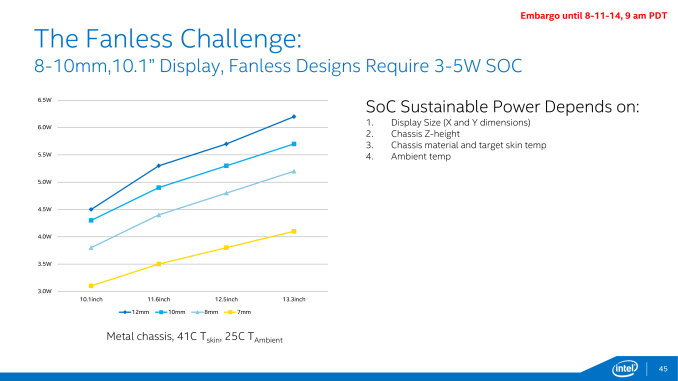
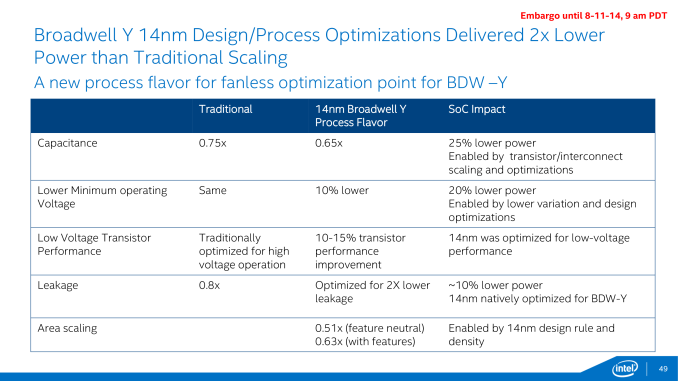
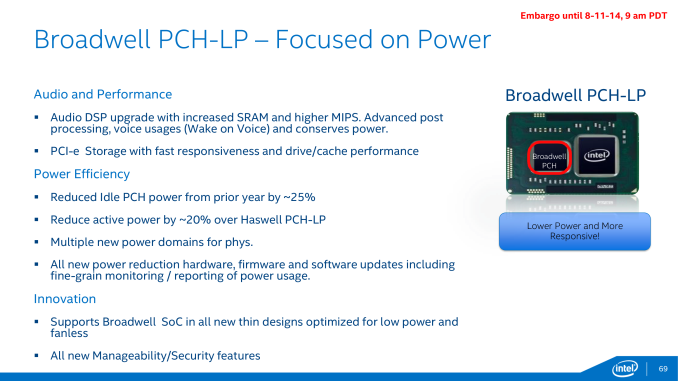
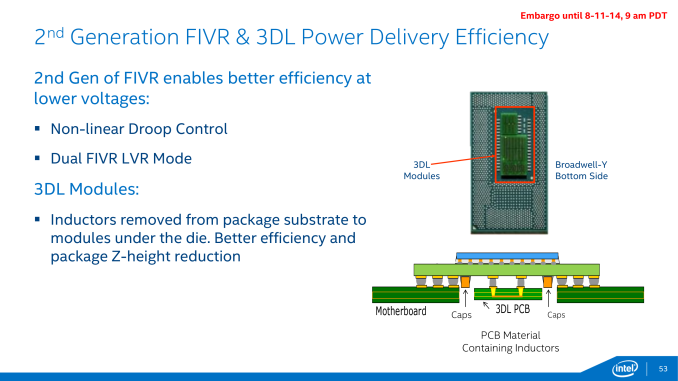

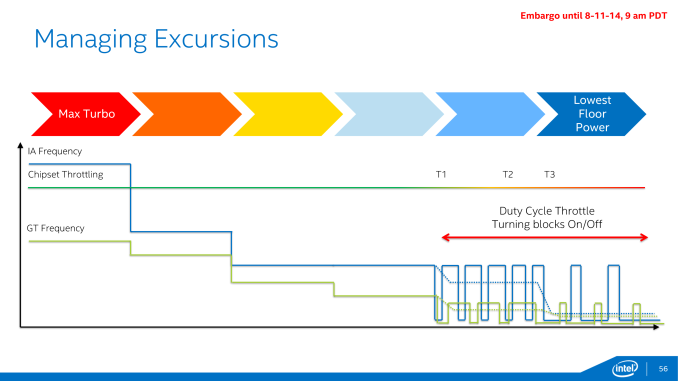








158 Comments
View All Comments
psyq321 - Tuesday, August 12, 2014 - link
Actually, apart from power-users I fail to see any tangible improvements in performance of modern CPUs that matter to desktop/notebook usage, Intel or otherwise.In the mobile space, it is improvements in GPU which mattered, but even that will eventually flatten once some peak is reached since graphics improvements on 4" / 5" screen can only matter to wide audiences up to some point.
However, there are surely enough customers that do look forward to more power - this is workstation and server market. Skylake and its AVX512 will matter to scientists and its enormous core count in EP (Xeon) version will matter to companies (virtualization, etc.).
Standard desktop, not so much. But, then again, ever since Core 2 Quad 6600 this was the case. If anything, large-scale adoption of SSDs is probably the single most important jump in desktop performance since the days of Conroe.
Khenglish - Monday, August 11, 2014 - link
I find the reduction in die thickness to be a big deal. Maybe this will prevent temperatures from getting out of control when the cpu core area gets cut in half for 14nm. High power 22nm cpus already easily hit 30c temperature difference between the cpu and heatsink.AnnonymousCoward - Tuesday, August 12, 2014 - link
Probably not. I'd guess thermal dissipation is the same.dgingeri - Monday, August 11, 2014 - link
PC sales are down mostly because people can keep their systems longer due to the lack of innovation coming from Intel on desktop chips and the lack of utilizing the current CPU technology by software developers. They could be so much more, if only developers would actually make use of the desktop CPU capabilities for things such as a voice command OS that doesn't need to be trained. Intel would then have a reason to produce more powerful chips that would trigger more PC sales.As it is, the current processor generation is less than 10% faster clock for clock compared to three generations ago. A great many thing aren't any faster at all. Know what? It doesn't even matter because nothing uses that much power these days.
Tablets and smartphones can't take the place of full PCs for most people. Their screens are just too small. Perhaps the younger generations prefer the small form factors right now, but give them a little time, and their eyes won't let them use such things. I can see the move to laptops, especially with 14-15" screens, but trying to show the same content on a 10" screen is just near unusable, and a 5" smartphone screen is just downright impossible. However, desktop PCs still have their place, and that's never going to change.
This push by "investors" for the tablet and smartphone market is just asinine. Broadwell isn't going to help sales all that much. Perhaps, they might sell some more Intel based tablets, but it won't be all that much of an improvement. Tablets have a niche, but it really isn't that much of one.
HanzNFranzen - Monday, August 11, 2014 - link
Tablets are a niche and not much of one? lol yea ok... well while you were asleep in a cave, over 195 million tablets were sold in 2013 between Android/Apple/Microsoft which is just shy of 80 million more than the previous year. World wide PC sales totaled 316M units, so we are talking nearly 2 tablets for every 3 PC's sold. Eh...small niche...dgingeri - Monday, August 11, 2014 - link
yeah, lots of people have them, but how much do they really use them? I have two, one Android and one Windows RT, and I only use them for reading books or for reading the web news while away from home. The Windows unit showed promise, since I could use it to run Office and terminal programs, but I ended up not using it at work anymore because it couldn't use a USB to serial adapter for talking to switches and raid arrays. It ended up being only half useful. They're nice to have for certain things, but they aren't as versatile as a PC. My parents own two, and two PCs, and they use the PCs far more. My older sister has one, and she barely uses it. Her 7 year old uses it to play games most of the time. My nephew has one, and he's only ever used it to read Facebook. It's a telling tale that everyone I've known who has one only has limited used for it.mapesdhs - Monday, August 11, 2014 - link
Point taken, but if people are *buying* them, irrespective of whether they use them,then it doesn't really matter.
Besides, this whole field of mobile computing, smart phones, tablets, now phablets,
etc., it's too soon to be sure where we're heading long-term.
Many people say the copout porting of console games to PCs with little enhancement
is one thing that's harmed PC gaming sales. This may well be true. Now that the newer
consoles use PC tech more directly, perhaps this will be less of an issue, but it's always
down to the developer whether they choose to make a PC release capable of exploiting
what a PC can do re high res, better detail, etc. Wouldn't surprise me if this issue causes
internal pressures, eg. make the PC version too much better and it might harm console
version sales - with devs no doubt eager to maximise returns, that's something they'd
likely want to avoid.
Ian.
az_ - Monday, August 11, 2014 - link
Ryan, could you add a size comparison to an ARM SOC that would be used in a tablet? I wonder how close are Intel in size. Thanks.name99 - Tuesday, August 12, 2014 - link
BDW-Y is 82 mm^2. The PCH looks like it's about a third of that, so total is maybe 115 mm^2 or so.In comparison, Apple A7 is about 100 mm^2.
A7 includes some stuff BDW-Y doesn't, and vice versa, so let's call it a wash in terms of non-CPU functionality.
BDW-Y obviously can perform a LOT better (if it's given enough power, probably performs about the same at the same power budget). On the other hand it probably costs about 10x what an A7 costs.
Krysto - Tuesday, August 12, 2014 - link
Sure, also let's conveniently forget that Broadwell Y benefits not only of 3D transistors, but a 2 generation node shrink, too, compared to A7. Now put A7 on 14nm and 3d transistors...and let's see which does better.This is the issue nobody seems to understand, not even Anand, or just conveniently ignored it when he declared that the "x86 myth is busted". At the time we were talking about a 22nm Trigate Atom vs 28nm planar ARM chip, with Atom barely competing on performance (while costing 2x more, and having half the GPU performance). Yet Anand said the x86 bloat myth is busted...How exactly?! Put them on the same process technology...and then we'll see if x86 myth is indeed busted, or it's still bloated as a pig.